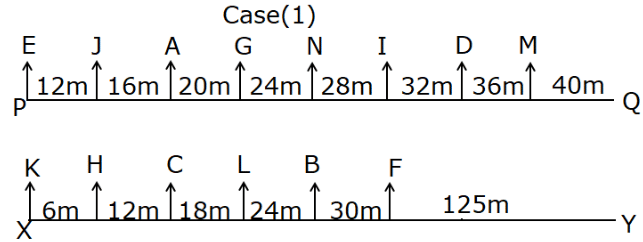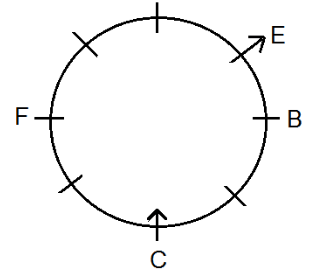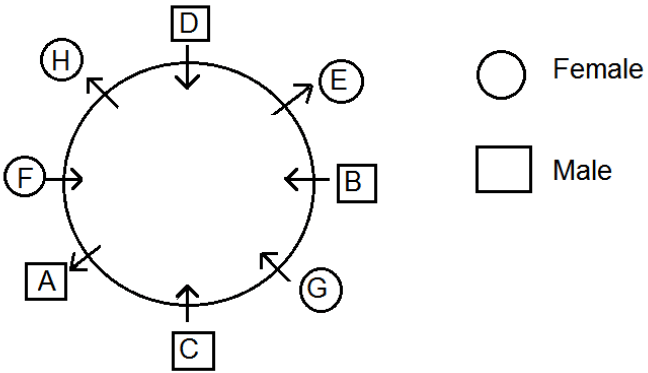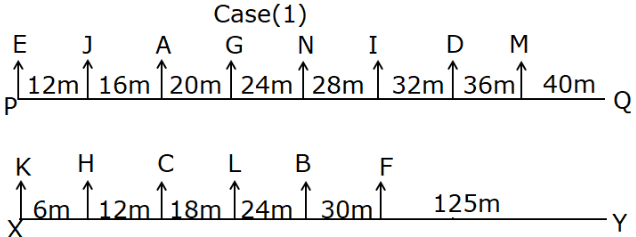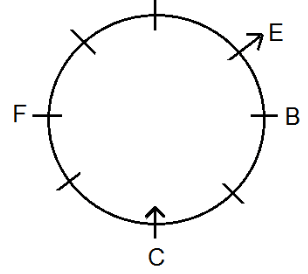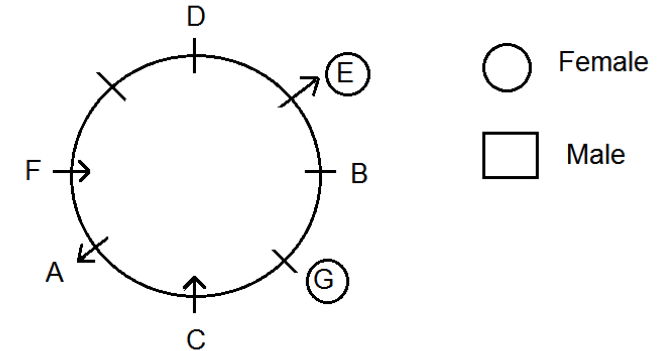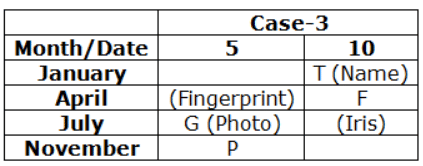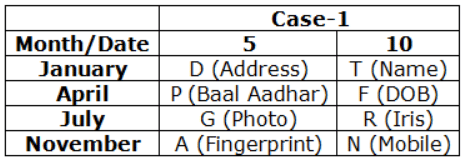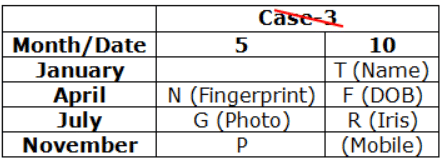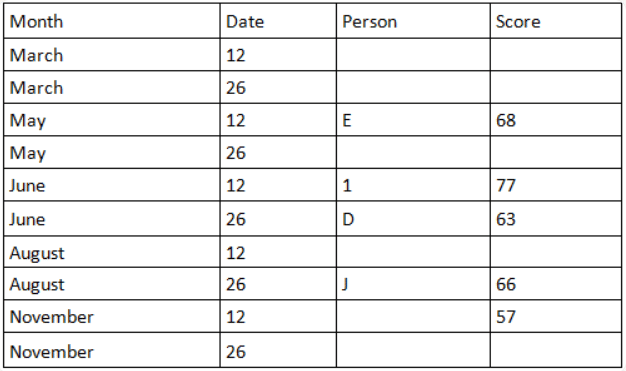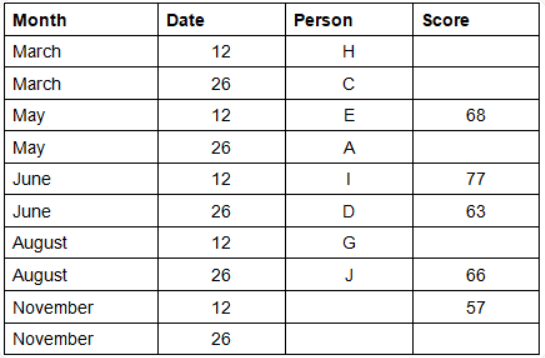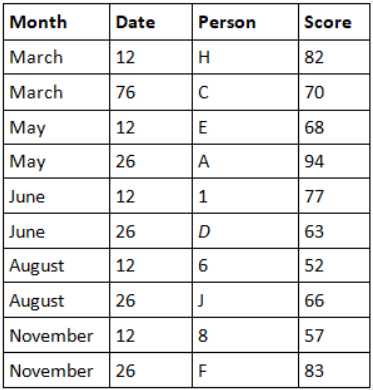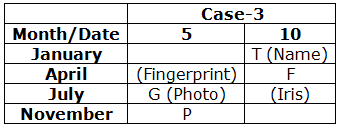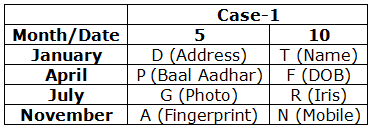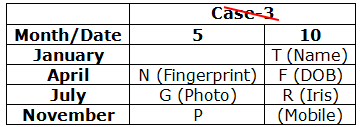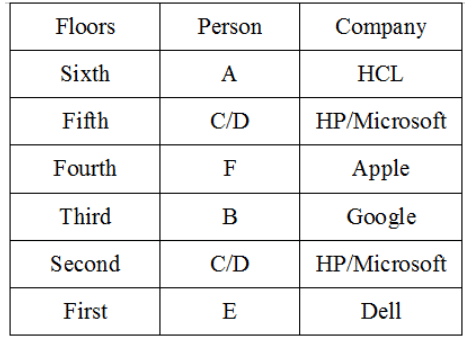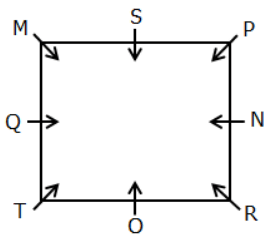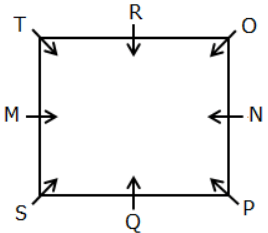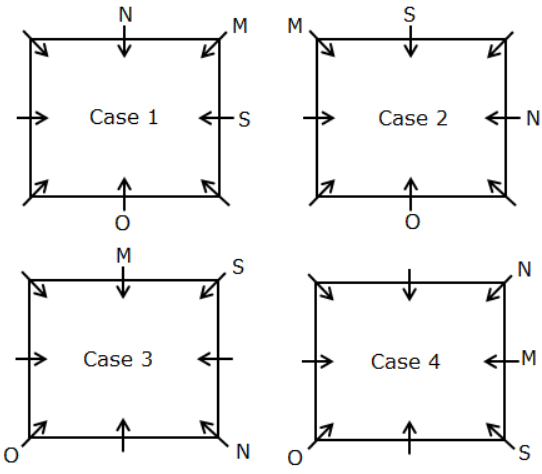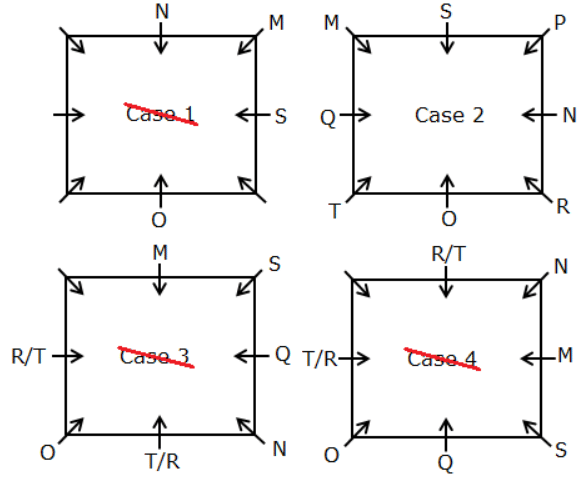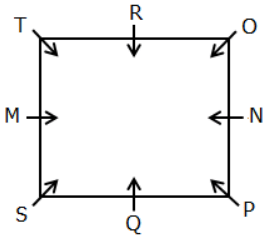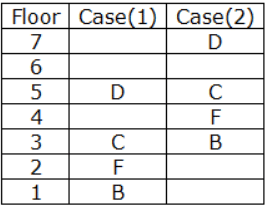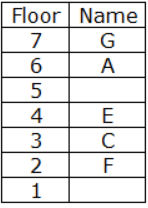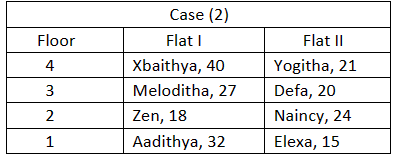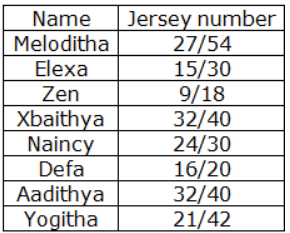SBI PO Mains Mock Test - 5 (New Pattern) - Bank Exams MCQ
30 Questions MCQ Test - SBI PO Mains Mock Test - 5 (New Pattern)
Study the following information carefully and answer the below questions.
Fourteen persons are sitting in two parallel rows viz.- PQ and XY as shown in the below diagram facing north. The distance between the adjacent persons in line PQ is a consecutive multiple of ‘4m’ whereas in line XY is a consecutive multiple of ‘6m’ from the left end. Distance between none of the adjacent persons is more than 40m.




Note:
(i) If it is given A sits in front of B, that means A must be sitting in row PQ whereas B sits in row XY, also the number of persons sitting to the left of both A and B is the same. The consecutive alphabetically named persons are not sitting together.The number of persons sitting in both rows is not same.
(ii) In the above diagram, other two rows ST and WZ are used to answer the question when needed.
J sits in front of the one who sits second to the left of L. J sits 60m to the left of N but none of them sits at the extreme end.H sits three places away from B, who sits 42m to the right of C. The number of persons sitting to the left of H is one less than the number of persons sitting to the right of I but both are not sitting in the same row. Only two persons sit between I and A who sits in front of C. The person sitting in front of H sits second to the left of G. At least two persons are sitting to the left of G. As many persons sit between E and G as between L and K. Neither K nor E sits adjacent to I. D neither sits adjacent to F nor sits at the extreme end. M sits to the right of I.
What is the distance of B from point Y?
Directions: Study the following information and answer the question.
A, B, C, D, E, F, G and H are eight friends that are sitting around a circular table, not necessarily in the same order. Three of them are facing outwards, while five are facing the centre. There are equal number of males and females in the group.
C is facing the centre. E is sitting third to the right of C. F is sitting third to the left of E. Three persons are sitting between F and B. The immediate neighbours of B are females. G is sitting third to the right of F. D is sitting third to the right of A. A is not an immediate neighbour of E. The immediate neighbours of E are males and are facing the centre. The immediate neighbours of D are females and are facing outwards. The one sitting third to the left of B is a male. No female is an immediate neighbour of G.
Who is sitting second to the right of E?
Study the following information carefully and answer the below questions.
Fourteen persons are sitting in two parallel rows viz.- PQ and XY as shown in the below diagram facing north. The distance between the adjacent persons in line PQ is a consecutive multiple of ‘4m’ whereas in line XY is a consecutive multiple of ‘6m’ from the left end. Distance between none of the adjacent persons is more than 40m.




Note:
(i) If it is given A sits in front of B, that means A must be sitting in row PQ whereas B sits in row XY, also the number of persons sitting to the left of both A and B is the same. The consecutive alphabetically named persons are not sitting together.The number of persons sitting in both rows is not same.
(ii) In the above diagram, other two rows ST and WZ are used to answer the question when needed.
J sits in front of the one who sits second to the left of L. J sits 60m to the left of N but none of them sits at the extreme end.H sits three places away from B, who sits 42m to the right of C. The number of persons sitting to the left of H is one less than the number of persons sitting to the right of I but both are not sitting in the same row. Only two persons sit between I and A who sits in front of C. The person sitting in front of H sits second to the left of G. At least two persons are sitting to the left of G. As many persons sit between E and G as between L and K. Neither K nor E sits adjacent to I. D neither sits adjacent to F nor sits at the extreme end. M sits to the right of I.
Four of the following five are alike in a certain way based on the given arrangement and thus form a group. Which one of the following does not belong to the group?
Directions: Study the following information and answer the question.
A, B, C, D, E, F, G and H are eight friends that are sitting around a circular table, not necessarily in the same order. Three of them are facing outwards, while five are facing the centre. There are equal number of males and females in the group.
C is facing the centre. E is sitting third to the right of C. F is sitting third to the left of E. Three persons are sitting between F and B. The immediate neighbours of B are females. G is sitting third to the right of F. D is sitting third to the right of A. A is not an immediate neighbour of E. The immediate neighbours of E are males and are facing the centre. The immediate neighbours of D are females and are facing outwards. The one sitting third to the left of B is a male. No female is an immediate neighbour of G.
How many persons are sitting between H and C if counted from the left of H?
Study the following information carefully and answer the questions given below
In a certain code language,
Certain people observes well is coded as %#< %^< &®> %$>
Facing lot of problem is coded as &@> &^> %®< &$<
Students went for vacation is coded as%*< &@> (?) %#<
Working better than yesterday is coded as %*> &#< &$< %^>
What is the code for “Faster growing behavior?”
Directions: Study the following information and answer the given question.
In alphabetical series A - Z, each letter is assigned a number starting from 1 to 26 and then, it is coded in a single digit (obtained by sum of digits of number assigned). For example, A is coded as 1, B is coded as 2, .., J will be coded as 1 (10 will be 1 + 0 = 1), K = 2 (11 will be 1 + 1 = 2) and so on.
In coded language
'Girl is famous' is coded as '7993 91 614631'
'What do you like' is coded as '5812 46 763 3925'
Following are some conditions which are required for solving the given question.
(i) If both the first and the last letters of a word are vowels, then the codes of both the vowels are to be interchanged.
(ii) If the first letter of a word is a vowel and the last letter is a consonant, then both are to be coded as @ and $, respectively.
(iii) If the first letter of a word is a consonant and the last letter is a vowel, then both are to be coded as # and *, respectively.
(If the word does not satisfy the conditions given above, then the letters of that word are to be coded as per the directions given above.)
What can be the code of 'nothing perfect'?
Study the following information carefully and answer the questions given below.
Eight persons A, D, F, G, N, P, R and T are attending E-Aadhar camp on two different dates i.e. 5 and 10 of four different months viz. January, April, July and November for updating eight different Aadhar details viz. Name, Mobile number, DOB, Address, Fingerprint, Photo, Iris and Baal Aadhar but not necessarily in the same order.
Note: The person whose name comes in the first half of the alphabetical series and the person whose name comes in the second half of the alphabetical series are attending the E-Aadhar camp on different dates of the same month and vice versa.
For example: If C attends on 5th of February then any person whose name comes in the first half of the alphabetical series doesn’t attend on 10th of February and vice versa.
Only three persons attend between P and the one who updates fingerprint. P attends in the month which has an even number of days but doesn’t attend at last. Only two persons attend between T and the one who updates photo. As many persons attend before the one who updates photo as after F. G attends immediately after F. The one who updates Iris attends two persons after F. T doesn’t attend in the same month as the one who updates fingerprint. The number of persons attending after the one who updates Iris is one more than the number of persons attending before the one who updates Name. R attends two persons before the one who updates mobile number. The number of persons attending before R is one more than the number of persons attending after the one who updates DOB. N doesn’t update fingerprint. D attends two persons before the one who updates Baal Aadhar.
Who among the following person attends E-Aadhar camp on 5th January?
Directions: Study the following information and answer the given question.
In alphabetical series A - Z, each letter is assigned a number starting from 1 to 26 and then, it is coded in a single digit (obtained by sum of digits of number assigned). For example, A is coded as 1, B is coded as 2, .., J will be coded as 1 (10 will be 1 + 0 = 1), K = 2 (11 will be 1 + 1 = 2) and so on.
In coded language
'Girl is famous' is coded as '7993 91 614631'
'What do you like' is coded as '5812 46 763 3925'
Following are some conditions which are required for solving the given question.
(i) If both the first and the last letters of a word are vowels, then the codes of both the vowels are to be interchanged.
(ii) If the first letter of a word is a vowel and the last letter is a consonant, then both are to be coded as @ and $, respectively.
(iii) If the first letter of a word is a consonant and the last letter is a vowel, then both are to be coded as # and *, respectively.
(If the word does not satisfy the conditions given above, then the letters of that word are to be coded as per the directions given above.)
Which of the following can be the code for 'also create ease'?
In the following questions, the symbols #, @, $, %, & and ? are used with the following meaning as illustrated below. In each of the questions given below statements are followed by some conclusions. You have to take the given statements to be true even if they seem to be at variance from commonly known facts. Read the conclusions and then decide which of the given conclusions logically follows from the given statements, disregarding commonly known facts
A#B→ Some A is B
A$B→ No A is B
A@B → Only a few A is B
A?B→ Only A is B
A%B→ All A is B
A&B→ Some A is not B
! → Possibility
Note: If ! is placed immediately after any of the symbols mentioned above then it will be considered as a possibility case of the symbol. For example A%!BàAll A being B is a possibility.
Statements:
January @ February % March; March $ April # May; May ? June
Conclusions:
I. January % June
II. February $ April
III. May % ! January
Directions: Study the following information carefully and answer the question.
Ten students, namely, A, B, C, D, E, F, G, H, I and J participated in quiz shows. The quiz shows were held on the 12th and 26th of five different months (March, May, June, August and November). Score obtained by a student on a given date was even in the months with 31 days and odd in the months with 30 days. Only one of the students participated on a particular date. No two students obtained the same score.
Two students participated between G and A, who participated in one of the months before B did. The total score of students who participated in March was 152. E participated in the quiz show in a month with 31 days, but not in the month in which C or J participated. D participated on the 26th of a month which had 30 days and in one of the months after C did. The total score of D and J was 129 and J scored 2 less than E. F participated in one of the months after J did and the difference between the scores of H and F was 1. Two students participated between the one who scored 63 and the one who scored 57. The number of students who participated between J and the one whose score was 83 was the same as that between C and the one whose score was 94. The number of students who participated in the quiz show before I did was double the number of students who participated after J did. B and F participated in the same month and F scored more than B. Two students participated between H and A and both of them participated before June. The difference between the scores of B and G was 5 and B scored more than G. H scored less than F. Two students participated between E and D, who scored 63 marks. I scored a multiple of 11, but not an even number, and he scored between 60 and 80.
Who among the following students participated in the quiz on 26th August?
Study the following information carefully and answer the questions given below.
Eight persons A, D, F, G, N, P, R and T are attending E-Aadhar camp on two different dates i.e. 5 and 10 of four different months viz. January, April, July and November for updating eight different Aadhar details viz. Name, Mobile number, DOB, Address, Fingerprint, Photo, Iris and Baal Aadhar but not necessarily in the same order.
Note: The person whose name comes in the first half of the alphabetical series and the person whose name comes in the second half of the alphabetical series are attending the E-Aadhar camp on different dates of the same month and vice versa.
For example: If C attends on 5th of February then any person whose name comes in the first half of the alphabetical series doesn’t attend on 10th of February and vice versa.
Only three persons attend between P and the one who updates fingerprint. P attends in the month which has an even number of days but doesn’t attend at last. Only two persons attend between T and the one who updates photo. As many persons attend before the one who updates photo as after F. G attends immediately after F. The one who updates Iris attends two persons after F. T doesn’t attend in the same month as the one who updates fingerprint. The number of persons attending after the one who updates Iris is one more than the number of persons attending before the one who updates Name. R attends two persons before the one who updates mobile number. The number of persons attending before R is one more than the number of persons attending after the one who updates DOB. N doesn’t update fingerprint. D attends two persons before the one who updates Baal Aadhar.
N attends the camp on which of the following month and date?
Directions: The following question consists of a question and two statements numbered I and II given below it. You have to decide whether the data provided in the statements are sufficient to answer the question.
A, B, C, D, E and F are six persons that live in a six storey building on different floors. Ground floor is named as first floor and floor above the ground floor is named as second floor and so on. They work for different companies, i.e HCL, Dell, Microsoft, Google, Apple and HP. F lives on the floor which is three floors above the floor of E, who lives on an odd numbered floor. There are two floors between the floors of C and D. C and D work for Microsoft and HP.
On which floor does B, who works for Google, live?
I. The one who lives on topmost floor works for HCL. F works for Apple.
II. C lives on the floor which is immediately below the floor of A. D lives on even numbered floor.
Study the following information carefully and answer the questions given below.
Eight persons viz. M, N, O, P, Q, R, S and T are sitting around a square table such that all of them are facing towards the center, but not necessarily in the same order. Four persons are sitting in the corners whereas four persons are sitting in the middle of the sides of the table. After throwing a dice, each person is moving in a certain direction as per the given conditions.
Two persons sit between M and O, where one of them sits at the corner of the table. S sits to the immediate left of M. The number of persons sitting between S and O is one more than the number of persons sitting between M and N. S and N didn’t sit opposite to each other. One person sits between T and R, where none of them sits adjacent to S. Q neither sits at any of the corners nor sits adjacent to R. Atleast one person sits between P and R when counted from both sides. Q doesn’t sit facing T.
All the persons are allowed to throw a dice once in alphabetical order. Based on the outcome and the following conditions, they are moving to certain positions as given.
I. If the outcome is an odd number (except odd prime numbers), then the person interchanges his position with the one who sits second to the left of him.
II. If the outcome is a prime number, then the person interchanges his position with the one who sits to the immediate right of him.
III. If the outcome is an even number (except even prime number), then the person interchanges his position with the one who sits third to the right of him.
IV. If none of the conditions follow, then the person remains in the same position.
V. The following is the outcome of all the persons in the alphabetical order from left to right: 2 6 4 3 1 6 5 1.
VI. The second person throws the dice, only after the first person changes his position and so on.
How many persons in the initial arrangement remain unchanged in their position when compared to the final arrangement after movement?
Directions: The following question is accompanied by three statements (A) or (I), (B) or (II) and (C) or (III). You have to determine the statement(s) which is/are sufficient/necessary to answer the question.
What does '$' mean?
A. '5$#3' means 'flowers are really good'
B. '7#35' means 'good flowers are related'
C. '7@^' means 'they were related'
Below questions consist of a question followed by some statements in option. Study the following information carefully and decide which of the following statement is sufficient to answer the below questions.
Seven persons – A, B, C, D, E, F, and G are living in seven floored building marked 1 to 7 from bottom to top respectively. Who among the person lives immediately below C?
Directions: Study the following information carefully to answer the question.
The following are the qualifications for post in a reputed company.
The candidate must
(a) be an MBA with at least 60% marks;
(b) be not less than 21 years and not more than 30 years of age as on 1-7-2016;
(c) have passed the selection test with at least 60% marks;
(d) be willing to pay a deposit of Rs. 60,000, to be refunded on completion of training.
However, if a candidate fulfils the above-mentioned criteria except:
I. (a) above, but has appeared for the last semester examination and obtained an aggregate of minimum 65% marks in first three semesters, his/her case may be referred to the G.M. of the company;
II. (d) above, but is willing to pay an amount of at least Rs. 40,000 and has obtained at least 70% marks in MBA, the case may be referred to the Asst. General Manager of the company.
In the following question, details of the candidate are given as regards his/her candidature. You have to read the information provided and decide his/her status based on the conditions given above and the information provided. You are not to assume anything other than the information provided in the question. All these cases are given to you as on 1-7-2016.
Naman is an MBA passed out in 2014 with 62% marks. He has cleared the selection test with 60% marks. He can pay the deposit of Rs. 50,000. His date of birth is 15th September, 1994.
Study the following information carefully and answer the below questions.
Eight persons – Meloditha, Elexa, Zen, Xbaithya, Naincy, Defa, Aadithya, and Yogitha are living in a four floor building marked 1 to 4 from bottom to top respectively. There are two flats on each floor viz.- flat I and flat II from west to east respectively. Each person wears a jersey with different numbers printed on the back.
Note:
I. If the number of letters in the person’s name is even, then their jersey numbers are obtained by multiplying the total number of letters of their name by either 4 or 5. (E.g.)The total number of letters in the name is 6. Then the person’s jersey number is either ‘24’ or ‘30’.
II. If the number of letters in the person’s name is odd, then their jersey numbers are obtained by multiplying the total number of letters of their name by either 3 or 6. (E.g) The total number of letters in the name is 3. Then the person’s jersey number is either ‘9’ or ‘18’.
III. If the person’s name starts with a letter which is in the first half of the alphabetical series, then the person lives on an odd numbered floor, else the person lives on an even numbered floor.
Naincy lives two floors below the one whose jersey number is a multiple of 10 but both are not living in the same flat. The one whose jersey number is 20 lives two floors above the one whose jersey number is 12 less than Meloditha in the same flat. Meloditha lives immediate southwest of the one whose jersey number is 11 less than the jersey number of Aadithya. Aadithya lives southwest of the one whose jersey number is six more than Zen.
What is the sum of the jersey number of the persons living on floor number 3?
Directions: Study the following information carefully to answer the question.
The following are the qualifications for post in a reputed company.
The candidate must
(a) be an MBA with at least 60% marks;
(b) be not less than 21 years and not more than 30 years of age as on 1-7-2016;
(c) have passed the selection test with at least 60% marks;
(d) be willing to pay a deposit of Rs. 60,000, to be refunded on completion of training.
However, if a candidate fulfils the above-mentioned criteria except:
I. (a) above, but has appeared for the last semester examination and obtained an aggregate of minimum 65% marks in first three semesters, his/her case may be referred to the G.M. of the company;
II. (d) above, but is willing to pay an amount of at least Rs. 40,000 and has obtained at least 70% marks in MBA, the case may be referred to the Asst. General Manager of the company.
In the following question, details of the candidate are given as regards his/her candidature. You have to read the information provided and decide his/her status based on the conditions given above and the information provided. You are not to assume anything other than the information provided in the question. All these cases are given to you as on 1-7-2016.
Lata is an MBA passed out in 2014 with 66% marks. She has passed the selection test with 60% marks and is willing to pay the required amount of deposit.
In the following questions, the symbols #, @, $, %, & and ? are used with the following meaning as illustrated below. In each of the questions given below statements are followed by some conclusions. You have to take the given statements to be true even if they seem to be at variance from commonly known facts. Read the conclusions and then decide which of the given conclusions logically follows from the given statements, disregarding commonly known facts
A#B→ Some A is B
A$B→ No A is B
A@B → Only a few A is B
A?B→ Only A is B
A%B→ All A is B
A&B→ Some A is not B
! → Possibility
Note: If ! is placed immediately after any of the symbols mentioned above then it will be considered as a possibility case of the symbol. For example A%!BàAll A being B is a possibility.
Statements:
Ball @ Bat # Gloves; Gloves $ Helmet ? Stumps; Helmet # Shoes
Conclusions:
I. Bat $ Helmet
II. Stumps $ shoes
II. Ball & Bat
Directions: In the question below, a statement is given followed by two courses of action, numbered I and II. A course of action is a step or administrative decision to be taken for improvement, follow-up or further action in regard to the problem, policy, etc. On the basis of the information given in the statement, you have to assume everything in the statement to be true, and then decide which of the suggested courses of action logically follow(s) for pursuing.
Statement: A major part of the local market in the city was gutted due to a short circuit, causing extensive damage to goods and property.
Courses of action:
I. The government should issue strict guidelines for all establishments regarding installation and maintenance of electrical fittings.
II. The government should relocate all the markets to the outskirts of the city.
In June 2025, Equitas Small Finance Bank Limited, known for its focus on banking services for underserved segments of the population, has entered into a bancassurance partnership with an insurance company. This collaboration is aimed at offering life insurance solutions to the bank's customers. Which of the following companies is involved in this partnership?
In April 2025, The Kathak Mahotsav, a prestigious annual event celebrating the rich tradition of Kathak dance, brings together prominent performers, gurus, and enthusiasts from all over the world. The 37th edition of this grand festival was held in New Delhi in 2025. One of the highlights of the event was the recognition of an important new initiative in the Kathak community. Which of the following initiatives was recognized at the 37th edition of the Kathak Mahotsav 2025 held in New Delhi?
Union Budget 2025–2026 announced a targeted scheme to enhance the leather and footwear industry’s global competitiveness and employment capacity. This initiative aims to support production expansion and increase exports significantly, generates turnover of 4 lakh crore and exports of over ₹ 1.1 lakh crore As per estimates, how many lakh jobs are expected to be generated through this focused sectoral initiative?
In July 2025, Which of the following statements regarding the RBI's decision to ban foreclosure charges on floating rate loans to MSEs are correct?
1. The RBI has banned foreclosure charges on floating rate loans for micro and small enterprises (MSEs), effective from
January 1, 2026.
2. The RBI has excluded small finance banks and regional rural banks (RRBs) from this new rule.
3. The new directive applies only to loans with a sanctioned amount exceeding ₹50 lakh.
In June 2025, the National Payments Corporation of India (NPCI) is set to roll out an upgraded version of the National Automated Clearing House in early July 2025. This iteration will bring performance improvements and enhanced security features for recurring transactions like salaries, pension disbursements, and SIPs. Which version of NACH is being launched?
In June 2025, the Karnataka cabinet, under CM Siddaramaiah, recently approved an increase in the housing scheme quota for religious minorities to align with central standards outlined in the Sachar Committee report. This ensures parity between state and national policy frameworks. What is the new percentage quota allotment?
In March 2025, which of the following statements regarding unclaimed bank deposits and RBI’s initiatives are correct?
1. Over ₹45,000 crore worth of unclaimed deposits have been transferred to the Depositor Education and Awareness Fund between 2019 and December 2024.
2. Unclaimed deposits refer to those that remain inactive or unclaimed for more than 5 years in current, savings, or term deposit accounts.
3. The RBI has introduced the UDGAM portal to streamline the process for citizens to identify and reclaim their unclaimed funds.
In May 2025, According to the latest data from the Reserve Bank of India (RBI), Non-Resident Indian (NRI) deposits in India reached an 11-year high in FY25, with significant growth in inflows. How much did the NRI deposits inflows reach for FY25, marking a 9.9% increase from FY24?
In May 2025, India hosted the first-of-its-kind global summit on audio-visual and entertainment business, aiming to unlock a USD 50 billion market by 2029. It was inaugurated by PM Narendra Modi and introduced the Indian Institute of Creative Technology (IICT) for Animation, Visual Effects, Gaming, Comics, and XR. What is the name of this summit?
In March 2025, In the approval of the Namrup-IV Fertilizer Plant by the Union Cabinet, which of the following statements is/are correct?
1. The plant will have an annual capacity of 12.7 Lakh Metric Tonnes (LMT) and is expected to be completed in 48 months.
2. The total project cost for the Namrup-IV Fertilizer Plant is ₹10,601.40 crore, with a Debt-Equity ratio of 70:30.
3. The project will be developed as a joint venture under the New Investment Policy (NIP) 2012, aimed at improving the fertilizer sector.





